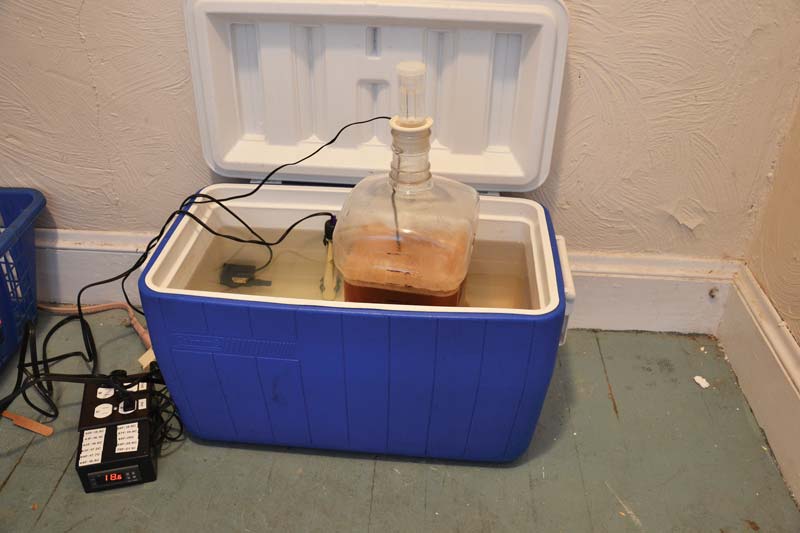The Importance Of Fermentation Temperatures
TroubleShooting
Kevin Schmid — Livonia, Michigan asks,
I have always fermented my beers at around 70–72 °F (21–22 °C). I just brewed a Kölsch and fermented it at the low end of the yeast manufacturer’s recommended optimum fermentation temperature range (62 °F/17 °C). It fermented great and the final gravity was 1.010. Are there any advantages or disadvantages to doing this and what impact might it have on the taste profile? I haven’t been able to see for myself as it is now in a secondary carboy conditioning for a couple more weeks before kegging.
Fermentation temperature definitely affects beer flavor and fermentation rate, however some yeast strains are more influenced by temperature than others. I will come back to this in a moment. Brewers who have a spot at home with a relatively constant temperature should consider making this their norm. My basement stays right at 64 °F (18 °C) throughout the year because my home’s air handler and basement dehumidifier are located in my basement. And because I am old school and like fermenting in carboys, it’s really handy to be able to design beers that taste great when fermented at 64 °F (18 °C). During my 23-year tenure at Springfield Brewing Company, we fermented beers at different temperatures. Ales were usually fermented at 64 °F (18 °C) using White Lab’s WLP001 (California Ale), except for our seasonal Kölsch that fermented at 61 °F (16 °C) using the same “Chico” strain, while we fermented lagers at 54 °F (12 °C) using the Augustiner strain.

Your question is about fermenting your Kölsch at 62 °F (17 °C) versus your normal 71 °F (22 °C) for other beers. In my experience using WLP001 (similar to SafAle US-05, Wyeast 1056, LalBrew BRY-97, among others), the cooler fermentation temperature typically results in a sulfur snap, most likely due to increased sulfur dioxide production and retention in the beer. And this is not a hit or miss observation. For about 20 years of using the same yeast strain at 64 °F (18 °C) for a wide variety of beers and 61 °F (16 °C) for Kölsch, I always noted the increased sulfur level. Because this added a lager-esque quality to a style that is often described as being similar to lagers, I liked the effect and stuck with the lower temperature. For me, this was a check in the advantage column.
But are these nuanced differences related to fermentation temperature detectable in the absence of a comparative beer, especially if the beer is a one-off brew? For example, if a Kölsch is fermented at 64 °F (18 °C) and has less sulfur in the nose, does the consumer have enough sensory memory and sense of scale to flag the aroma as being less than another beer that they aren’t tasting? In your case, you produced a very nice Kölsch when fermenting at 62 °F (17 °C), but you don’t know how the same batch would have been different if it were fermented at 71 °F (22 °C). Conventional wisdom suggests that the fermentation rate would have been a bit quicker and the resultant beer a bit more estery with less sulfur (cool fermentations are related to sulfur dioxide concentration). My bet is that your beer would have turned out well fermented warmer, while you know that it turned out well fermenting cool.
So why do yeast suppliers include guardrails around fermentation temperature? One obvious reason is that these companies want customers to be happy with their products and suggest temperatures that set the brewer up for success. It’s like the note on a beer label to consume beer before some date and to chill the beer before consuming. Another reason for the fermentation suggestions is that some yeast strains simply clock out below a certain temperature. While it is true that fermentation temperatures above about 80 °F (27 °C) are not ideal for most yeast strains, just about every brewing strain ferments quite well in very warm environments. The maximum temperatures are given to reinforce the importance of keeping things cool. Of course, saison and kveik strains are the outliers and break all sorts of conventional rules!
My most surprising experience related to this topic has been fermenting lagers at 64 °F (18 °C). I felt compelled to give this method a try using the famed Weihenstephaner W-34/70 because of the number of commercial brewers who are singing the praises of this method. I am a lager lover and was totally convinced that I was going to find all sorts of technical flaws in my beer; none-the-less I decided to brew a sacrificial beer. To my amazement, the resulting beer was great. Surely something went awry, so I fermented another lager strain at 64 °F (18 °C) and it was also great! Conclusion? Great lagers don’t have to be fermented in the 46–54 °F (8–12 °C) range and lagers don’t taste fruity when fermented warmer.
In past columns, I have touted the benefits of the KISS — keep it simple Shell (my middle name) — approach to brewing, which has almost always worked for me. If you have a spot in your home that has a consistent temperature, consider tailoring your brews around your environment. And if you conclude that your beers are best when fermented on the cool end of the spectrum, consider some type of cooling to establish an environment that allows you to brew a wide array of great beers with as few adjustments as possible. Like many of my answers, I took a detour down a street that hopefully added a bit of context and extra information related to your specific question.

